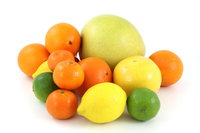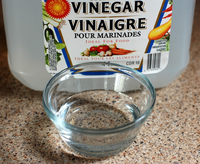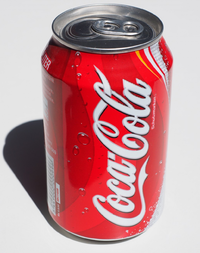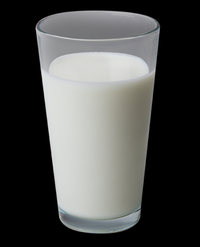Difference between revisions of "Acid"
(→Examples) |
(→Examples) |
||
| Line 63: | Line 63: | ||
===Examples=== | ===Examples=== | ||
: HCl(s) → H<sup>+</sup>(aq)+Cl<sup>-</sup>(aq) | : HCl(s) → H<sup>+</sup>(aq)+Cl<sup>-</sup>(aq) | ||
| − | : H<sub>2</sub>SO<sub>4</sub>(s) | + | : H<sub>2</sub>SO<sub>4</sub>(s) ⇌ H<sup>+</sup>(aq)+HSO<sub>4</sub><sup>-</sup>(aq) |
| − | : HNO<sub>3</sub>(s) | + | : HNO<sub>3</sub>(s) ⇌ H<sup>+</sup>(aq)+NO<sub>3</sub><sup>-</sup>(aq) |
| − | : H<sub>2</sub>CO<sub>3</sub>(s) | + | : H<sub>2</sub>CO<sub>3</sub>(s) ⇌ H<sup>+</sup>(aq)+HCO<sub>3</sub><sup>-</sup>(aq) |
| − | : H<sub>3</sub>PO<sub>4</sub>(s) | + | : H<sub>3</sub>PO<sub>4</sub>(s) ⇌ H<sup>+</sup>(aq)+H<sub>2</sub>PO<sub>4</sub><sup>-</sup>(aq) |
| − | : CH<sub>3</sub>COOH(s) | + | : CH<sub>3</sub>COOH(s) ⇌ H<sup>+</sup>(aq)+CH<sub>3</sub>COO<sup>-</sup>(aq) |
Revision as of 18:07, 4 January 2019
Contents
Key Stage 3
Meaning
An acid is a chemical dissolved in water that has a pH less than 7.
About Acids
- Acids can be an Irritant, Harmful or Corrosive and should be handled with care.
- When an acid is dissolved in solution the Hydrogen atoms in the molecule become free to move around and these are what make it an acid.
- Acids can be concentrated or dilute.
- Acids can be weak or strong which depends on the type of acid and the concentration.
- Acids turn Litmus paper red.
- Acids turn Universal Indicator pink, red, orange or yellow depending on the strength of the acid.
Some common Acids you should know:
- Hydrochloric Acid - Found in the stomach.
- Citric Acid - Found in Citrus fruits.
- Ethanoic Acid - The common name for vinegar.
- Sulphuric Acid - Found in Electrical Cells.
Examples
| Car batteries contain Sulphuric Acid at around pH 0. | Citrus fruits have Citric Acid in them at around pH 2. | Vinegar is made of Ethanoic Acid at around pH 2.5. |
| Fizzy drinks contain Carbonic Acid at around pH 3. | Coffee is slightly acidic at pH 5. | Milk has a small amount of Lactic Acid giving it pH 6.5. |
Key Stage 4
Meaning
An acid is a compound which is able to donate H+ ions when dissolved in water to produce a solution with a pH less than 7.
About Acids
Foundation
- Acids form from ionic compounds where there is an ionic bond between a Hydrogen ion and another part of the molecule.
- When an acidic compound dissolves in water the Hydrogen ion becomes dissociated from the molecule and is free to move separately in the solution.
- The Hydrogen ions in an acid will accept electrons from any metal which is higher on the reactivity series than Hydrogen. This is because those metals can lose their electrons more easily than the Hydrogen atom.
- The acidity of an acid is measured on the pH scale. The more Hydrogen ions in a solution the lower the pH.
There are several common reactions of acids you should know:
- Acid + Metal → Metal Salt + Hydrogen
- Acid + Metal Oxide → Metal Salt + Water
- Acid + Metal Hydroxide → Metal Salt + Water
- Acid + Metal Carbonate → Metal Salt + Carbon Dioxide + Water
Higher
- The concentration of an acid is determined by how many grams of acid are dissolve per litre (decimetre cubed) of water. A dilute acid has very little compound dissolved per litre while a concentrated acid has a large mass of compound dissolved per litre.
- When a compound does dissolve in water to produce an acid not all of the Hydrogen ions will dissociate from the compound. The strength of an acid, or its acidity, is determined by how easily Hydrogen ions are formed. The more easily Hydrogen ions form, the stronger the acid (the higher the acidity.
- For a pH decrease of 1 there needs to be 10 times the number of dissociated Hydrogen ions per litre. This will be affected by the concentration of acid and the strength of the acid (acidity).
Examples
- HCl(s) → H+(aq)+Cl-(aq)
- H2SO4(s) ⇌ H+(aq)+HSO4-(aq)
- HNO3(s) ⇌ H+(aq)+NO3-(aq)
- H2CO3(s) ⇌ H+(aq)+HCO3-(aq)
- H3PO4(s) ⇌ H+(aq)+H2PO4-(aq)
- CH3COOH(s) ⇌ H+(aq)+CH3COO-(aq)





